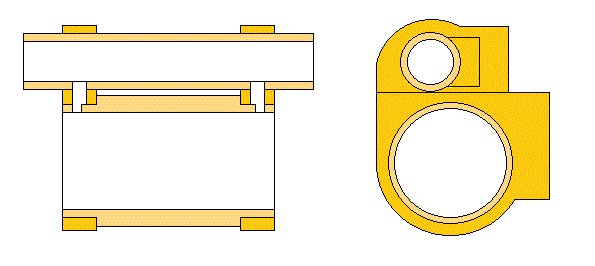syrtismajor
Junior Member
- Joined
- Feb 15, 2010
- Messages
- 50
- Reaction score
- 21
Hi all!
Here is another question from me regarding my potential design for a 3.5" gauge locomotive...
One of the main components I'll need are cylinders, and unfortunately there are no available castings on the market that'll fulfil my needs (trust me I've checked). I've considered getting some cast but to be honest I am not a fan of them as I have had a bad few in the past, and all from different suppliers.
Now, I know that all cylinder castings available are either Cast Iron or LG2 bronze. I also know that it is possible to 'fabricate' the cylinder blocks (I have seen this done before and read stories of it being easily achieved on club locos) often using brass as the main frame and bronze for the liners.
I have planned out that the cylinder itself will be composed of two brass 'frames' and a bronze cylinder, while the valve block will be of four parts (the liner being bronze again). Together these parts will form a piston valve cylinder closely resembling a standard cast part with similar thickness of materials etc...
Now (finally) to the question!
Is LG2 bronze the best material to use for the cylinder?
I know of a website that offers LG2 round bar (but it also confusingly refers to it as SAE.660 which is a different form of bronze )
)
There is also a supplier that can provide PB.1 bronze round bar and SAE.660 bronze hollow round bar
So, I know ideally I should follow the casting convention and use LG2 gunmetal bronze, but is there a better material to use?
LG2 Gunmetal? - solid bar only, lots of boring!
PB.1 Phosphor Bronze? - as above and is more expensive
PB.102 Phosphor Bronze? - as above again, and most expensive
SAE.660 Leaded Bronze? - can be bought hollow... cheapest option!
None of these?
Many thanks in advance!
Here is another question from me regarding my potential design for a 3.5" gauge locomotive...
One of the main components I'll need are cylinders, and unfortunately there are no available castings on the market that'll fulfil my needs (trust me I've checked). I've considered getting some cast but to be honest I am not a fan of them as I have had a bad few in the past, and all from different suppliers.
Now, I know that all cylinder castings available are either Cast Iron or LG2 bronze. I also know that it is possible to 'fabricate' the cylinder blocks (I have seen this done before and read stories of it being easily achieved on club locos) often using brass as the main frame and bronze for the liners.
I have planned out that the cylinder itself will be composed of two brass 'frames' and a bronze cylinder, while the valve block will be of four parts (the liner being bronze again). Together these parts will form a piston valve cylinder closely resembling a standard cast part with similar thickness of materials etc...
Now (finally) to the question!
Is LG2 bronze the best material to use for the cylinder?
I know of a website that offers LG2 round bar (but it also confusingly refers to it as SAE.660 which is a different form of bronze
There is also a supplier that can provide PB.1 bronze round bar and SAE.660 bronze hollow round bar
So, I know ideally I should follow the casting convention and use LG2 gunmetal bronze, but is there a better material to use?
LG2 Gunmetal? - solid bar only, lots of boring!
PB.1 Phosphor Bronze? - as above and is more expensive
PB.102 Phosphor Bronze? - as above again, and most expensive
SAE.660 Leaded Bronze? - can be bought hollow... cheapest option!
None of these?
Many thanks in advance!






